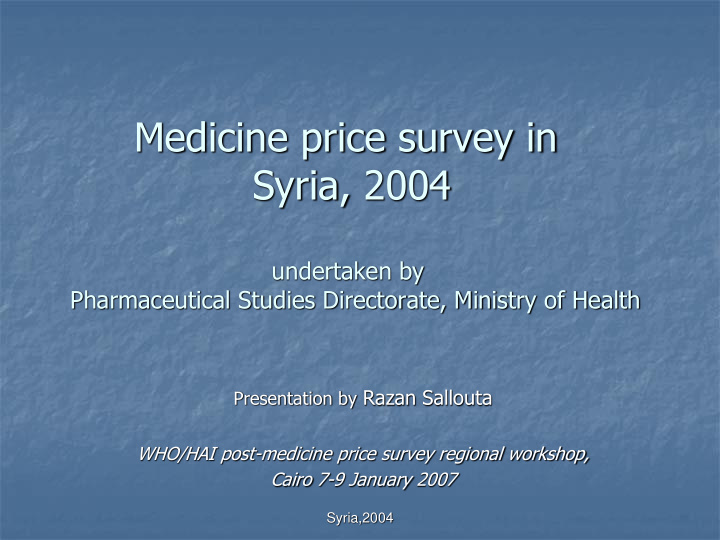



Medicine price survey in Syria, 2004 undertaken by Pharmaceutical Studies Directorate, Ministry of Health Presentation by Razan Sallouta WHO/HAI post-medicine price survey regional workshop, Cairo 7-9 January 2007 Syria,2004
Country background Population in millions: 18 % of rural population:49.8 % Total adult literacy rate: 93 % GDP per capita: 1216 US $ Total health expenditure/capita: 55.46US $; 4.56 % of GDP Government health expenditure/capita : 27.25US $; 2.25%of GDP National Health Insurance exists in Public Sector Syria,2004
Methodology Number of medicines surveyed: 27 • Core 22 Supplementary 5 Note: only 13 innovator brands surveyed • Year of MSH reference price used: 2002 Number of regions surveyed: 4 • • Total number of facilities sampled: 100 Sector (patient prices) Number Public NS Private retail pharmacies 57 Other sector: Private patients in private 43 sections of public hospitals NS = not surveyed Syria,2004
Availability Private Other: Private inpatients in public hospitals IB LPG IB LPG 0% (n=27) 0% 93% Median availability 98% 95% (n=13) % 100 75 Pri-IB Pri-LPG 50 Other-IB Other-LPG 25 0 Co-trimoxazole Glibenclamide Ranitidine Syria,2004
Prices: summary MPRs and examples Procurement Private Other: Private inpatients IB LPG IB LPG IB LPG 6.99 1.54 9.6 2.51 1.9 Median MPR diclofenac 21.68 4.52 23.71 6.32 4.74 loratadine 2.92 0.72 3.41 0.98 0.77 amitriptyline 3.05 2.77 3.88 2.91 IB = innovator brand LPG = lowest priced generic Syria,2004
Affordability (No. of days ’ wages) Daily wage 100 SP Private Other: private inpatients ~ $ 2 US IB LPG IB LPG Co-trimoxazole, 8+40mg/ml, 0.5 0.2 0.2 suspension, 70ml Atenolol, 50mg, tab, 30 1.8 0.6 0.5 Diclofenac, 25mg, tab, 60 3.2 0.8 0.6 Syria,2004
Price components – Syrian pricing formula Type of charge Amount of charge Raw materials, manufacturing & packaging Cost price Manufacturer's profit 20% Propaganda 8% Wholesalers mark-up 8% Pharmacists mark-up is regressive, based on pharmacists procurement price 1 – 40 SP 30% 41 – 80 SP 20% 81 – 200 SP 15% 201 – 500 SP 10% 501 and over 8% Note: pharmacy markup is not applied across total procurement price eg if procurement price is 75 SP then mark-up is 30% for first 40 SP plus 20% for remaining 35 SP Syria,2004
Main Findings 1- Availability of generics was very good – in public hospitals & private pharmacies 2- In the private sector, innovator brands were high priced. Most generics were reasonably priced although some were expensive. 3- Some treatments, even with generics, are not affordable to low-paid Syrians 4- Some public procurement prices are high compared to MSH reference prices Syria,2004
Recommendations The findings of this study should be used to adjust the draft national medicines policy An in-depth study of the private sector should be initiated to investigate prescribing and dispensing practices, including whether innovator brands are more frequently prescribed than generic equivalents Where prices of specific medicines are very high (MPR of 10 or more), investigation should occur to identify means to reduce these prices Study pricing methods in other countries Monitor the impact of policy changes by regular surveys of medicine prices, availability and affordability Syria,2004
Follow-up activities 1- Plan to increase the number of medicines that should be surveyed. 2- Use the survey findings to develop and implement policies and practices that result in lower prices, and more affordable treatments for all Syrians. Syria,2004
Recommend
More recommend